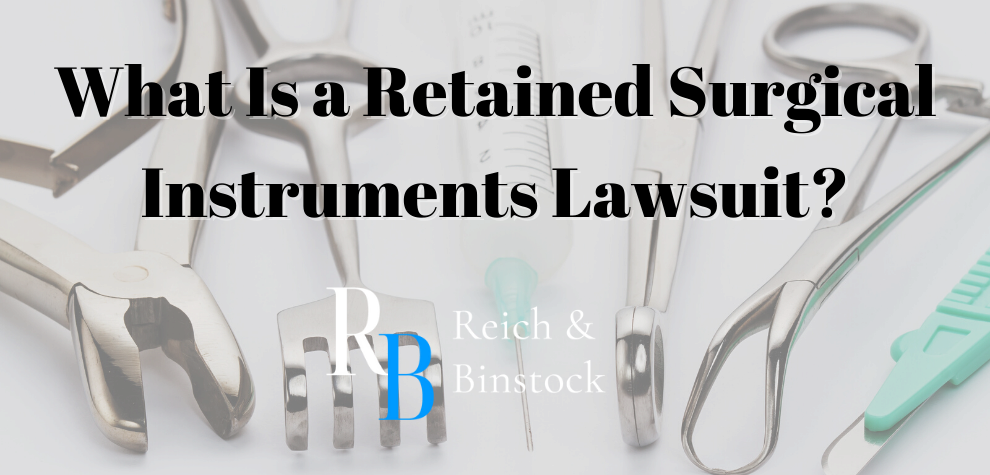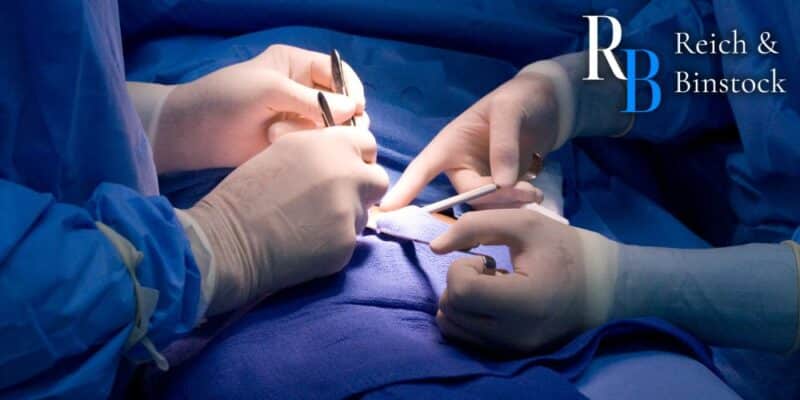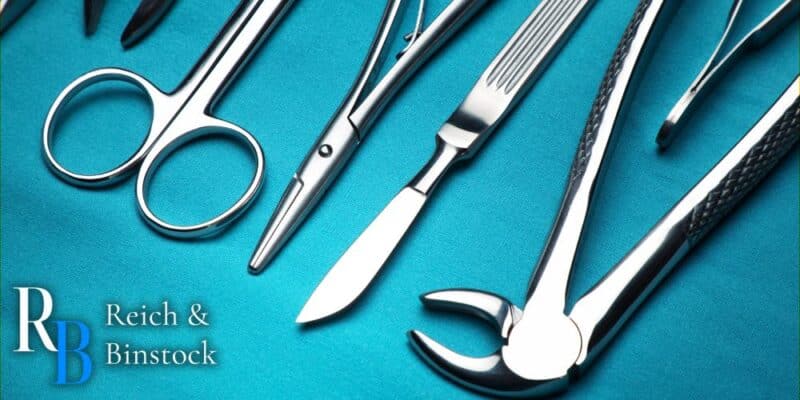According to some estimates, surgical debris or devices are left inside a patient’s body thousands of times per year in the United States. Retained surgical devices can cause pain and perforate organs, potentially resulting in life-threatening infections. In most cases, more surgery is required. When this happens it is a clear case of medical malpractice and you may be entitled to file retained surgical instruments lawsuits.
It’s obvious that leaving a surgical device in a patient’s body is a medical mistake. Patients suffering harm and/or the additional agony and pain of surgery removing the retained surgical device can file a medical malpractice case for compensation. If you are the victim of a surgical device left inside your body, you need the help of a qualified and experienced Houston medical malpractice lawyer. Medical practice lawsuits are subject to a statute of limitations in Texas, so don’t wait. Call Reich & Binstock today to talk about your potential retained surgical instruments lawsuit.
What Are Retained Surgical Items?
Retained surgical objects are devices mistakenly left behind in a patient’s body after surgery. This happens when a surgeon forgets to remove needles, scalpels, clamps, or any other tool after a procedure ends. Gossypiboma is an injury that occurs when a surgeon fails to remove a sponge, pad, or towel. Negligence is often the cause. In the operating room, this is unacceptable.
What Retained Surgical Items Are Left Behind After Operations?
Surgical objects are left inside patients 39 times every week, according to the John Hopkins Institute. These medical errors are commonly called “never events.” That’s because medical specialists believe that they should never happen during surgery. These mistakes are avoidable and developing complications deadly to patients is possible. Mistakes like these do happen, unfortunately. A retained surgical object usually results in serious, life-threatening health issues for the patient.
Surgical materials that may be forgotten inside patients include:
- Scalpels and broken scalpel tips
- Suture needles
- Tubing & Clamps
- Wires for guiding
- Scissors
- Surgical sponges
- Tweezers
- Medical surgical gloves
- Medical surgical face masks
What is the Most Common Retained Surgical Item Left Behind After Surgery?
The surgical sponge is the most common surgical object left behind after treatment, according to data from medical studies. Because sponges are designed to absorb fluid, they frequently turn red from the blood they absorb and blend in with a patient’s internal anatomy. Furthermore, a retained sponge may become obscured by organs within the body cavity.
After the surgery is completed, the forgotten sponge eventually causes an infection. Patients with retained surgical sponges are frequently plagued by life-threatening infections from within. They only have a limited amount of time to get medical treatment.
How Are Retained Surgical Objects Found In the Body?
After seeking medical assistance, radiological scans such as x-rays, sonograms, and magnetic resonance imaging (MRI) are used to locate retained surgical objects inside the patient. Often additional surgical procedures are required to remove the foreign objects. These costs add up plus there is an increased danger of infection and other risks associated with any surgery.
Sometimes damage to vital organs is such that entire sections of the intestine or colon are removed in corrective surgery. This can lead to life-long debilitating conditions for the patient.
By following proper medical protocol, these incidents can be completely avoided. Hospitals used to rely on counting tools prior to and after a surgery, which is prone to human error. Barcoded or RF (radio frequency) tags are used on surgical tools, such as sponges, in many hospitals today. This aids in accounting for all items after the surgery, especially during emergency surgeries when quick actions are key.
Why Do Retained Surgical Instrument Errors Occur?
Surgeons and members of a surgical team need a tracking system, such as checklists or counts, for sponges, surgical tools, and other materials used during a procedure. However, in order for these methods to be effective, they must be strictly followed. Certain situations increase the likelihood of surgical assistants leaving a surgical device behind.
Ignore the Procedure
Tools must be counted at the beginning and end of surgery. Electronic tracking systems are available now to keep track of supplies like sponges. However, only a small percentage of medical facilities use this technology.
Deviation from Procedure
If quick decisions are made due to problems during a procedure, or if medical teams are quickly organized for emergency surgery, they may deviate from routine procedures. The probability that the surgical team encounters complications rises when this happens.
Communicate Poorly
Personnel need thorough training in the procedure and communicating with each other. In extended procedures, for example, teams of technicians and nurses may rotate in and out of surgery.
Signs and Symptoms of a Retained Surgical Item
Even though they may cause persistent pain at any surgery site, surgical devices are most commonly left in the abdominal cavity or pelvis. These tools can also move inside the body, causing discomfort and severe damage to internal organs. Metal items left behind present more symptoms than fabric. The risk of harm or death is great, so sufferers must notice the signs and symptoms of a retained surgical item as soon as possible. These include:
- Stools that are black, bloody, or tar-like
- Blood is coughed up or vomited.
- Constipation
- Urination difficulties
- Abscess or a fistula
- Drainage from the wound site or nearby
- Breathing, eating, swallowing, and other basic functions are difficult.
- Severe infection
- Feeling unwell (i.e. progressive weakness after surgery)
- Severe pain or swelling/sensitivity near or around the surgery site
- Fever
- Headaches that are severe
- Tenderness or swelling near or around the surgery site
- Lymph nodes swollen
- Extreme leg discomfort
- Unexplained weight loss
There are difficulties in these cases, since one person may experience specific symptoms while another may only experience pain. Furthermore, symptoms may appear immediately or may take months or years to manifest. Making matters worse, doctors may misdiagnose a patient’s symptoms and prescribe remedies for the incorrect sickness.
What You Can Do After a Retained Surgical Instrument Injury?
The most common methods to diagnose a retained surgical item use imaging tests such as ultrasound, mammography, MRI, and fluorodeoxyglucose positron emission tomography. Sometimes a physician orders tests for a different reason and discovers a surgical tool is inside the patient.
Both surgical devices and gossypibomas pose major health hazards. An infection or a fibrinous reaction (interruption of normal clotting) can result from a surgical instrument left behind in the body. Another surgery may be needed to remove the object if a surgical device is left behind. If the object causes serious internal bleeding or injury it may require emergency surgery.
Unfortunately, a retained object can be mistaken for tumors or harmful growths if not recognized quickly. This results in additional surgery that is unneeded, costly, and intrusive. These surgeries are not only expensive, but they also inflict a great deal of stress.
There is clear evidence of medical negligence by the medical professionals and the treating facility when gossypibomas and surgical objects are located inside a patient. You may be eligible for compensation if you or a loved one were hurt by a retained surgical device. The Houston medical malpractice lawyers at Reich & Binstock have successfully held large healthcare providers accountable for their errors.
Seeking Compensation for Retained Surgical Instrument Injuries
It is the legal duty of surgeons and other medical professionals to provide their patients with a recognized level of care. A patient undergoing another surgery to remove a forgotten surgical device is an inconceivable medical error.
Patients who experience this have a strong malpractice case. Res ipsa loquitur is the legal notion that applies to sponges or tools that are left behind. It is a Latin phrase that means “The object speaks for itself.” The presence of the object is proof of malpractice because surgical instruments should never be left inside a patient.
The following compensation is available to malpractice victims:
- Medical treatments needed for the harm caused
- If the patient is left permanently disabled, future medical treatments or care
- Wages lost throughout the rehabilitation process
- Future wages and earning potential lost due to a lifelong handicap
- Suffering and pain
Sadly, these same victims are often at a disadvantage against the teams of attorneys employed by doctors, hospitals, and their insurance companies. This is why it is crucial to have a free case review by an experienced medical malpractice attorney and qualified medical experts. Increase your chances of receiving a full and fair settlement by contacting the dedicated attorneys at Reich & Binstock today. We protect our clients’ rights and aggressively pursue the most favorable outcome possible in their retained surgical instruments lawsuits.
Contact a Retained Surgical Instruments Houston Medical Malpractice Lawyer
You may be eligible to seek compensation if you were hurt by a retained surgical instrument. The law firm of Reich & Binstock represents serious injury victims across the country. Additionally, we represent surviving family members in wrongful death cases when a loved one has died. In this situation, we encourage you to reach out to us.
Your or a loved one’s losses will be fully accounted for after we investigate the harm this surgical error caused. All parties responsible for your injuries are identified and we seek full compensation on your behalf for this medical malpractice. You are kept completely informed throughout the duration of your case.
We investigate medical errors and assist clients on a contingency fee basis. There is no charge unless we win your case and get you the compensation you need and deserve. Please contact the Houston retained surgical instruments lawsuits attorneys at Reich & Binstock today. Call 713-622-7271 for a free consultation or fill out the contact form below to get started on your retained surgical instruments lawsuit.



















